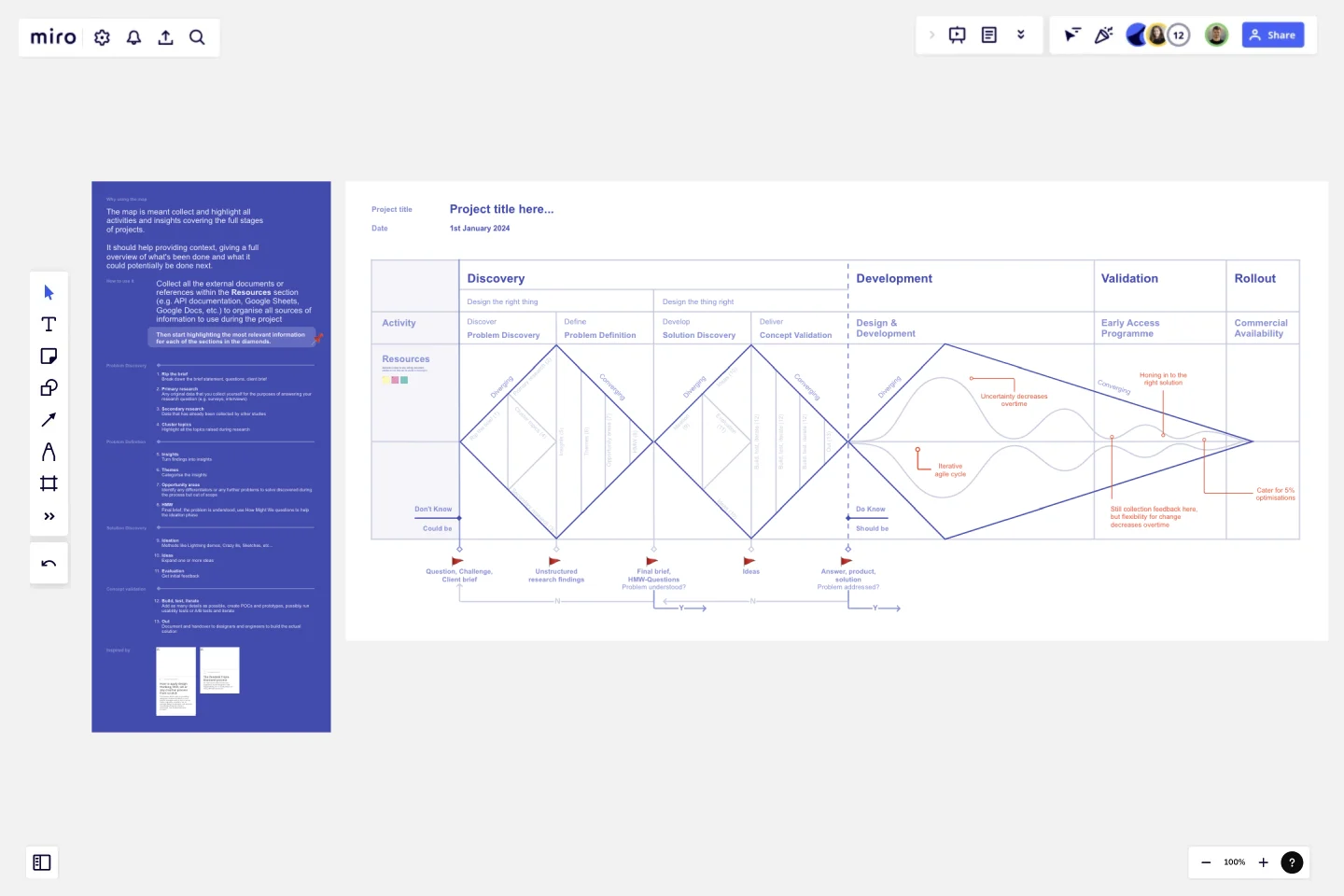[Triple Diamond] Project Map
In summary, the project map serves as a comprehensive tool for collecting, organising, and presenting information across all stages of project execution.
By providing context, highlighting past achievements, and delineating future actions, it facilitates informed decision-making, fosters collaboration, and promotes adaptive planning. As a dynamic and versatile resource, the map empowers stakeholders to navigate the complexities of project management with clarity and confidence. The purpose of the map is to comprehensively capture and illuminate all activities and insights that span across the entirety of the project stages. Its primary objective is to offer context and provide a holistic overview of past accomplishments while also delineating potential future actions.
The map serves as a repository for all project-related endeavors, encompassing initiation, planning, execution, monitoring, and closure phases. Consolidating information from each stage, it offers stakeholders a clear understanding of the project's progression and current standing.
One of the key functions of the map is to provide context. It achieves this by organizing data in a manner that illustrates the interconnectedness of various project components. Through visual representation, stakeholders can discern the relationships between different tasks, milestones, and outcomes. This contextualization facilitates informed decision-making and ensures alignment with overarching project objectives.
Moreover, the map offers a comprehensive overview of completed activities. By cataloging past accomplishments, it enables stakeholders to appreciate the journey thus far and recognise milestones achieved. This retrospective analysis not only instills a sense of progress but also provides valuable insights into the efficacy of previous approaches. Understanding what has already been accomplished serves as a foundation for devising future strategies and optimizing resource allocation.
In addition to showcasing past achievements, the map serves as a springboard for future endeavors. By delineating potential next steps, it empowers stakeholders to chart the course forward with clarity and purpose. Whether identifying areas for improvement, anticipating challenges, or exploring new opportunities, the map serves as a roadmap for informed decision-making. It not only guides strategic planning but also fosters innovation and proactive problem-solving.
Furthermore, the map facilitates effective communication and collaboration among project stakeholders. By offering a centralized platform for sharing information and insights, it promotes transparency and alignment of goals. Whether engaging with team members, clients, or external partners, stakeholders can leverage the map to convey progress, discuss strategies, and solicit feedback. This collaborative approach fosters a sense of ownership and collective responsibility, thereby enhancing overall project outcomes.
Another important aspect of the map is its adaptability. Recognising that projects are dynamic and subject to change, the map is designed to accommodate evolving circumstances and requirements. Through regular updates and revisions, it remains current and relevant, reflecting the latest developments and insights. This flexibility ensures that stakeholders are equipped with up-to-date information to make timely and informed decisions. Any feedback is appreciated if you use it for your projects!
This template was created by Stefano D'Avascio.
Get started with this template right now.
Features Audit Template
Works best for:
Desk Research, Product Management, User Experience
Add new features or improve existing features—those are the two paths toward improving a product. But which should you take? A features audit will help you decide. This easy, powerful product management tool will give you a way to examine all of your features, then gather research and have detailed discussions about the ones that simply aren’t working. Then you can decide if you should increase those features’ visibility or the frequency with which it’s used—or if you should remove it altogether.
Fishbone RCA
Works best for:
Problem solving, Strategy
Use the Fishbone RCA template to conduct a thorough root cause analysis (RCA) for any problem. This template helps you break down complex issues into manageable categories, enabling you to identify the underlying causes. It's an effective tool for improving processes, solving problems, and preventing future issues.
Async Roadmap Sharing
Works best for:
Roadmaps, Planning, Mapping
Async Roadmap Sharing template facilitates asynchronous collaboration on roadmap planning and execution. By providing a centralized platform for sharing updates, feedback, and insights, teams can ensure alignment and transparency across distributed teams. This template promotes flexibility and inclusivity, allowing team members to contribute to roadmap discussions at their own pace and asynchronously across different time zones.
Year Timeline Template
Works best for:
Timeline, Planning
The Year Timeline template provides a comprehensive view of annual events and milestones. Perfect for planning yearly goals, tracking progress, and scheduling important dates, this template helps you stay organized and focused throughout the year.
DevOps Roadmap Template
Works best for:
Documentation, Product Management, Software Development
DevOps teams are constantly creating code, iterating, and pushing it live. Against this backdrop of continuous development, it can be hard to stay abreast of your projects. Use this DevOps Roadmap template to get a granular view of the product development process and how it fits into your organization's product strategy. The DevOps Roadmap lays out the development and operations initiatives you have planned in the short term, including milestones and dependencies. This easy-to-use format is easily digestible for audiences such as product, development, and IT ops.
Inspired: Creating Products Customers Love
Works best for:
Product Management, Planning
Inspired: Creating Products Customers Love template guides product managers in developing innovative and customer-centric products. By emphasizing empathy, ideation, and validation, this template fosters a deep understanding of customer needs and preferences. With sections for brainstorming ideas, defining features, and validating concepts, it facilitates the creation of compelling products that resonate with target audiences. This template serves as a roadmap for delivering exceptional customer experiences and driving product success.
